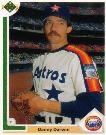
|
This Could Be Your Ad! Sponsor . . .
Hell's Bells! Advertise your business, or pay tribute to your favorite team! |

|
This Could Be Your Ad! Sponsor . . .
Hell's Bells! Advertise your business, or pay tribute to your favorite team! |
 | |
| Hell's Bells, he's good! |
The first factor we must consider is how the closer role has evolved over the years. Bill James discusses this subject thoroughly in his essay, "Valuing Relievers," which can be found in his New Historical Abstract. James categorizes the usage of relievers into five categories. The three which concern us line up as follows:
1) The Hoyt Wilhelm usage pattern - This is intended to represent the way relievers were used between 1963 and 1978 in which the relief ace would enter any close game, particularly tied games, unless the pitcher had really been overworked in the preceding games. This pattern of usage optimized the value of each inning pitched by the relief ace.
2) The Bruce Sutter usage pattern - These pitchers from the late 70's-late 80's were held back for save situations, but averaged two innings per appearance. This usage pattern resulted in a les optimal value even than the modern one, but the extra innings pitched tend to make each individual relief season much more valuable.
3) The Robb Nenn usage pattern - The modern usage pattern in which the closer is used for just one inning in save situations.
It is important to realize that as time has advanced, it has become much easier to record saves. You cannot record a save if you enter the game with the score tied, and you can chalk up more saves if you're rested enough to pitch more games. Therefore, since the first half of Lee Smith's career came during the Bruce Sutter era, his save total is slightly more impressive than Hoffman's.
Similarly, as time has advanced, the number of blown saves from relief aces has decreased. Obviously, if you're being used predominately in one run games, you're far more likely to blow a save than a pitcher who is used equally often in one, two, and three run games. Also, you're twice as likely to blow a save when used for a two-inning save than for a one inning save. Therefore, Hoffman's save percentage of 89.5% isn't as superior to Smith's mark of 82.3% as you might think at first glance. Perhaps it would be more illustrative to compare Hoffman directly to the two other dominant closers of this era.
| IP | SV | SV% | ERA | RA | |
| Trevor Hoffman | 882.1 | 479 | 89.5 | 2.70 | 3.00 |
| Mariano Rivera | 878.2 | 413 | 88.2 | 2.29 | 2.51 |
| Billy Wagner | 700.2 | 323 | 86.6 | 2.38 | 2.61 |
Wagner is essentially two years younger than Rivera and four years younger than Hoffman; it's interesting that he's rarely mentioned in the same breath as those other two greats. As you can see, Hoffman can't really hold a candle to Wagner or Rivera in terms of runs allowed, but he beats them both in save percentage. Part of this discrepancy can be explained by park effects and the unbalanced schedule; Hoffman's career ERA drops to 2.58 when you exclude his appearances in Colorado. But there still appears to be a certain clutch ability to Hoffman, an ability to hunker down in the really tight games.
Now if you add Rivera's postseason totals to his regular season numbers, he has pitched 990 innings, saved 447 games, and totaled an ERA of 2.12. I don't think a slight edge in save percentage is enough to consider Hoffman Rivera's equal. But at worst, Hoffman is the third best closer of his era.
I'd like to end with something more definitive, but we're just going to have to wait and see. Hoffman turns 39 next month and is under contract for one more season with the Padres (at a bargain of a price, I might add). Yet he does not rely on a dominant fastball to get hitters out. His best pitch is his changeup, always has been, and so long as the velocity differential between his fastball and his changeup remains steady, he could probably pitch at his current effectiveness for another five years if he wanted to.
But as it stands now, Hoffman remains in the pack of great but not outstanding closers, huddled among Smith, Wagner, John Franco, Dan Quisenberry, Goose Gossage, Kent Tekulve, Tom Henke, and John Hiller. What he does over the next few seasons will determine whether Trevor is just one of the crowd or whether he is truly one of the best saviors of all time.
Disagree with something? Got something to add? Wanna bring up something totally new? Keith Glab resides in Chicago, Illinois, and can be reached at keith@baseballevolution.com.


 Tired of defensive stats that are misleading, arbitrary, and complicated?
Tired of defensive stats that are misleading, arbitrary, and complicated?Then pick up your copy of The Fielding Bible today for $7 off the cover price! Read Keith's Review to find out more. |